Markers are an essential tool for artists, designers, and hobbyists alike, and with so many types and brands available, finding the right one can be overwhelming. In this blog post, we'll explore the differences between alcohol-based, water-based, and xylene-based markers, examine the uses of various tip types (chisel, fine, and brush), and compare some of the top marker brands on the market today.
Types of Markers: Alcohol-Based, Water-Based, and Xylene-Based
Understanding the different types of markers is essential for selecting the right tool to match your specific artistic or professional needs. Markers come in various formulations—such as alcohol-based, water-based, and xylene-based—each offering unique properties that affect blending, drying time, color intensity, and the surfaces they can be used on.
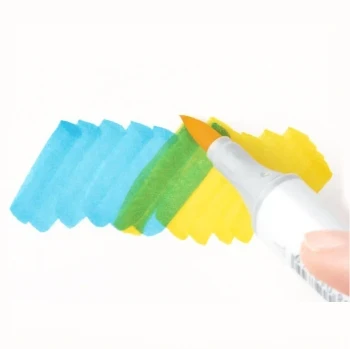
Alcohol-Based Markers
Pros:
Alcohol-based markers, such as Copic and Winsor & Newton ProMarkers, are known for their quick-drying properties, vibrant colors, and excellent blendability. The alcohol-based ink is permanent, waterproof, and provides smooth coverage without streaking.
Cons:
They tend to bleed through paper, so thicker paper or marker pads are recommended. Additionally, they may have a strong odor, which can be bothersome in poorly ventilated spaces.
Best For:
Professional illustrations, manga, comics, and graphic design.

Water-Based Markers
Pros:
These markers, such as Tombow Dual Brush Pens, are ideal for blending and layering without the risk of bleeding through paper. They are also non-toxic, odorless, and easy to clean up, making them perfect for beginners and younger artists.
Cons:
Water-based markers can sometimes cause paper to warp, and they may not provide the same vibrant color saturation as alcohol-based markers. The colors can also fade over time if exposed to light.
Best For:
Hand lettering, calligraphy, bullet journaling, and watercolor effects.
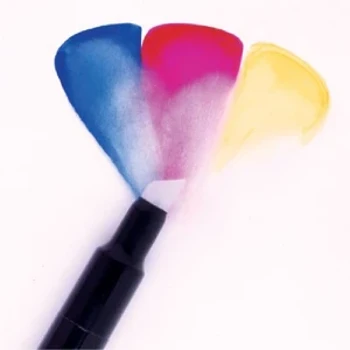
Xylene-Based Markers
Pros:
Xylene-based markers, like Chartpak AD Markers, offer highly saturated colors and the ability to blend seamlessly. They are particularly effective on various surfaces such as plastic, glass, metal, and wood, making them a versatile choice for mixed media projects.
Cons:
The xylene solvent produces a strong odor and may be harmful if inhaled for prolonged periods. Additionally, xylene-based markers can bleed through paper and cause staining.
Best For:
Mixed media art, industrial design, and creating vibrant, bold illustrations.
Marker Type Reference Chart:
| Marker Type | Pros | Cons | Best For | Popular Brands |
|---|
| Alcohol-Based | Vibrant colors, quick-drying, blendable | Bleeds through paper, strong odor | Illustrations, graphic design, manga | Copic, Prismacolor, Winsor & Newton |
| Water-Based | Non-toxic, no bleed-through, easy cleanup | Warps paper, less vibrant, fades | Hand lettering, journaling, watercolor art | Tombow, Crayola |
| Xylene-Based | Highly saturated, versatile on surfaces | Strong odor, harmful if inhaled | Mixed media, industrial design, bold art | Chartpak AD Markers |
Key Takeaways:
- Alcohol-Based Markers like Copic Sketch, Winsor & Newton ProMarkers, and Prismacolor Premier offer excellent blendability, vibrant colors, and are ideal for professional work. Copic markers stand out for their refillable and replaceable nibs, making them cost-effective in the long run.
- Water-Based Markers like Tombow Dual Brush Pens are ideal for hand lettering, journaling, and watercolor effects. They are non-toxic, easy to clean up, and provide smooth blending capabilities suitable for softer, more nuanced artwork.
- Xylene-Based Markers like Chartpak AD Markers are perfect for bold illustrations, mixed media, and industrial design due to their highly saturated colors and versatility on different surfaces. However, they come with a strong odor and may require good ventilation during use.
Marker Tips: Chisel, Fine, and Brush Tips
The tip style of a marker can significantly shape the way you approach your artwork and the effects you achieve. Each type of marker tip offers unique qualities that can impact line thickness, precision, texture, and versatility, allowing for different artistic techniques.
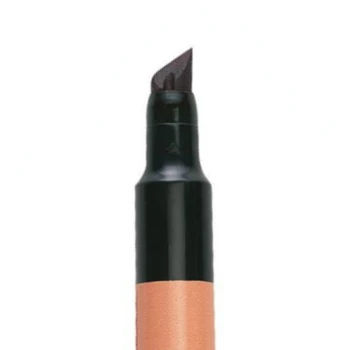
Chisel Tip Markers
Use:
Chisel tips are versatile, offering both broad strokes and fine lines, depending on the angle at which they are held. They are great for filling in large areas quickly or creating calligraphic effects.
Best For:
Graphic design, architectural drawings, and general-purpose coloring.
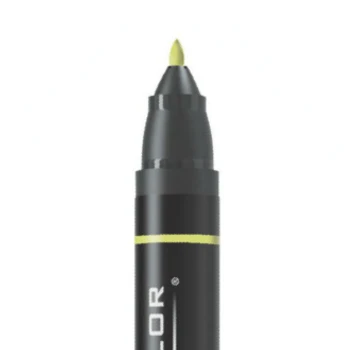
Fine Tip Markers
Use:
Fine tips are ideal for precise details, line work, and outlining. They allow for controlled, clean lines and are often used for sketching and detailed illustrations.
Best For:
Technical drawing, intricate illustrations, and detailed coloring.

Brush Tip Markers
Use:
Brush tips mimic the feel of a paintbrush, offering dynamic line variation and smooth, expressive strokes. They are excellent for blending, shading, and creating gradients.
Best For:
Hand lettering, manga, and expressive illustrations.
Comparing Top Marker Brands
Now that we have a solid understanding of the different types of markers and how they can be used, it’s time to compare some of the top brands in the market. Leading brands like Copic, Prismacolor, Tombow, Chartpak, and Winsor & Newton each offer unique features tailored to various artistic and professional needs. From the refillable, alcohol-based Copic markers known for their blendability and precision, to the xylene-based Chartpak AD Markers praised for their bold, saturated colors, each brand brings its own strengths. Whether you need fine details, smooth gradients, or versatile dual tips, comparing these brands helps you choose the best markers for your creative projects.
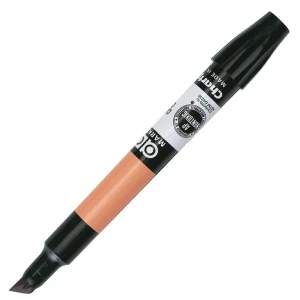
Chartpak AD Markers
Type: Xylene-based
Tip Options: Single nib (tri-nib design)
Features: Known for their vibrant, opaque colors and ability to blend on various surfaces, these markers are a favorite for mixed media and industrial design projects.
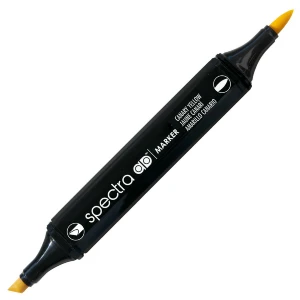
Chartpak Spectra Markers
Type: Alcohol-based
Tip Options: Dual-tip (chisel and fine)
Features: Provides smooth, streak-free coverage with a range of vibrant colors. They are designed for both precision and broad coverage.

Copic Sketch
Type: Alcohol-based
Tip Options: Dual-tip (brush and chisel)
Features: Refillable with replaceable nibs and a wide range of colors. They are highly favored for their exceptional blendability and consistent ink flow.

Copic Original
Type: Alcohol-based
Tip Options: Dual-tip (fine and chisel)
Features: Known for precision work, they are ideal for technical drawings and illustrations. They offer replaceable nibs and refills.

Copic Ciao
Type: Alcohol-based
Tip Options: Dual-tip (brush and chisel)
Features: A more affordable version of the Copic Sketch, with the same high-quality ink but a smaller color range and non-refillable option.
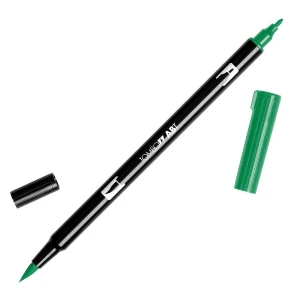
Tombow Dual Brush Pens
Type: Water-based
Tip Options: Dual-tip (brush and fine)
Features: Excellent for blending and creating watercolor effects. Ideal for hand lettering, calligraphy, and journaling.
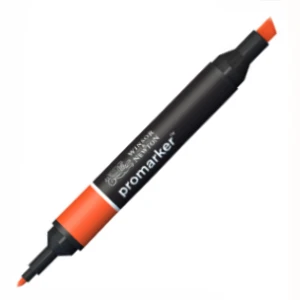
Winsor & Newton ProMarkers
Type: Alcohol-based
Tip Options: Dual-tip (chisel and fine)
Features: Known for their consistent ink flow, strong color saturation, and smooth blending. Great for professional artists and designers.
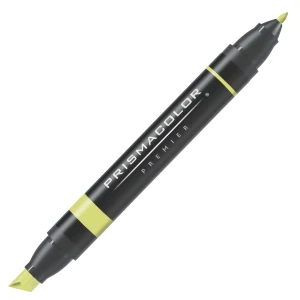
Prismacolor Premier Chisel/Fine Markers
Type: Alcohol-based
Tip Options: Dual-tip (chisel and fine)
Features: Delivers rich, vibrant colors and a smooth application. Ideal for both broad coverage and detailed work.
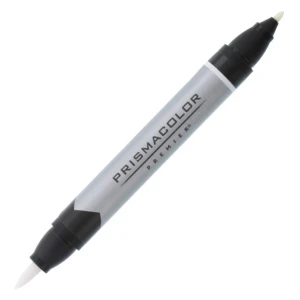
Prismacolor Premier Brush/Fine Markers
Type: Alcohol-based
Tip Options: Dual-tip (brush and fine)
Features: Offers the flexibility of a brush for expressive strokes and a fine tip for precise lines. Perfect for illustrations and hand lettering.
Marker Type Reference Chart:
| Brand/Marker |
Base Type |
Tip Style |
Refillable? |
Blendability |
Primary Use |
Special Features |
| Chartpak AD Markers |
Xylene-Based |
Chisel Tip |
No |
Excellent |
Mixed media, industrial design, bold illustrations |
Highly saturated colors, versatile on various surfaces |
| Chartpak Spectra Markers |
Alcohol-Based |
Dual Tip (Chisel/Brush) |
No |
Good |
General-purpose art, illustration, design work |
Flexible brush tip for varied line widths, smooth coverage |
| Copic Sketch |
Alcohol-Based |
Dual Tip (Brush/Chisel) |
Yes |
Excellent |
Professional illustration, manga, fashion design |
Refillable, replaceable nibs, wide range of colors |
| Copic Original |
Alcohol-Based |
Dual Tip (Chisel/Fine) |
Yes |
Excellent |
Technical drawings, detailed work, illustration |
Refillable, replaceable nibs, precision work |
| Copic Ciao |
Alcohol-Based |
Dual Tip (Brush/Chisel) |
No |
Excellent |
Beginners, hobbyists, manga |
Affordable, vibrant colors, suitable for learning |
| Tombow Dual Brush Pens |
Water-Based |
Dual Tip (Brush/Fine) |
No |
Good |
Hand lettering, journaling, watercolor effects |
Blendable, water-soluble, flexible brush tip |
| Winsor & Newton ProMarkers |
Alcohol-Based |
Dual Tip (Chisel/Fine) |
No |
Good |
Graphic design, professional use, illustration |
Consistent ink flow, strong color saturation |
| Prismacolor Premier Chisel/Fine |
Alcohol-Based |
Dual Tip (Chisel/Fine) |
No |
Very Good |
Illustration, broad and detailed work |
Rich, vibrant colors, dual-tip flexibility |
| Prismacolor Premier Brush/Fine |
Alcohol-Based |
Dual Tip (Brush/Fine) |
No |
Very Good |
Expressive illustrations, manga, general use |
Flexible brush tip for varied line width and detail work |
Industries and Their Preferred Types of Markers
Different industries and professions often have specific preferences when it comes to the types of markers they use, based on the unique requirements of their work. Here’s a look at which markers are commonly favored across various fields:
Architecture and Drafting:
- Preferred Markers: Alcohol-Based Markers (e.g., Winsor & Newton ProMarkers, Copic Original)
- Why: Architects and drafters require markers that deliver consistent line quality and precision. Alcohol-based markers are ideal for technical drawings, floor plans, and blueprints, as they offer a range of line widths and do not smear or smudge easily.
Graphic Design and Illustration:
- Preferred Markers: Alcohol-Based Markers (e.g., Copic Sketch, Prismacolor Premier)
- Why: Graphic designers and illustrators often need markers that offer vibrant, saturated colors, smooth blending, and quick-drying properties. Alcohol-based markers provide these benefits, allowing artists to create high-quality, professional artwork with precision and control.
Interior Design:
- Preferred Markers: Xylene-Based Markers (e.g., Chartpak AD Markers), Alcohol-Based Markers (e.g., Copic Sketch)
- Why: Interior designers often need to render vibrant and accurate color representations of fabrics, materials, and finishes. Xylene-based markers like Chartpak AD Markers provide rich color saturation and versatility on various surfaces, while alcohol-based markers offer clean blending and precise detailing.
Fine Art and Mixed Media:
- Preferred Markers: Xylene-Based Markers (e.g., Chartpak AD Markers), Water-Based Markers (e.g., Tombow Dual Brush Pens)
- Why: Fine artists and mixed media creators appreciate the rich, vibrant colors and smooth blending capabilities of xylene-based markers for bold, impactful artwork. Water-based markers are also favored for their ability to mimic watercolor effects and blend easily, providing flexibility in mixed media projects.
Calligraphy and Hand Lettering:
- Preferred Markers: Water-Based Markers (e.g., Tombow Dual Brush Pens)
- Why: Calligraphers and hand-lettering artists often prefer water-based markers due to their smooth ink flow, flexible brush tips, and non-bleeding properties. These markers allow for beautiful gradients and color transitions, perfect for lettering and decorative art.
Education and Hobbyists:
- Preferred Markers: Water-Based Markers (e.g., Crayola, Tombow Dual Brush Pens), Alcohol-Based Markers (e.g., Copic Ciao)
- Why: For students, educators, and hobbyists, water-based markers are ideal due to their non-toxic, odorless nature and easy-to-clean properties. Alcohol-based markers like Copic Ciao offer an entry-level, affordable option with vibrant colors and blending capabilities, perfect for those learning and experimenting with their craft.
Fashion Design:
- Preferred Markers: Alcohol-Based Markers (e.g., Copic Sketch, Prismacolor Premier)
- Why: Fashion designers use markers to create vivid sketches of garments and textiles. Alcohol-based markers provide the depth of color, smooth blending, and layering needed to represent various fabric textures and designs effectively.
Each type of marker brings its own strengths to the table, and the choice often depends on the specific needs of your industry. Understanding these preferences can help you select the right markers to achieve your desired results, whether you're working in fashion, design, architecture, or fine arts.
Marker Care and Maintenance
To get the most out of your markers, proper care and maintenance are essential:
- Store Horizontally: This prevents ink from pooling at one end, which can cause uneven flow.
- Cap Your Markers Tightly: Always replace the caps immediately after use to prevent the ink from drying out.
- Use the Right Paper: Choose paper that is designed for your type of marker to prevent bleed-through and reduce wear on the nibs.
- Clean Tips Regularly: For markers with brush or fine tips, clean the nibs gently to remove any debris or dried ink, which can cause clogging or inconsistent lines.
- Refill When Needed: For refillable markers, like Copic, regularly refill them to maintain consistent color output and extend the life of the marker.
Choosing the Best Paper for Markers
The type of paper you use with markers can significantly impact the quality and appearance of your artwork. The right paper will prevent bleeding, allow for smooth blending, and enhance the vibrancy of your colors. Here’s a guide to choosing the best paper for your markers, along with some top recommended brands:
Paper Types for Different Markers:
Alcohol-Based Markers:
- Best Paper: Smooth, bleed-proof paper that prevents ink from seeping through. Look for marker paper that is specifically designed to handle alcohol-based inks.
- Recommended Brands:
- Canson XL Marker Paper: This paper is ultra-smooth and prevents bleeding through, ideal for blending and layering.
- Strathmore 400 Series Marker Paper: Bleed-resistant and smooth surface, perfect for rendering with alcohol-based markers.
- X-Press It Blending Card: A favorite among Copic marker users, this paper offers excellent blending properties and a smooth finish.
Water-Based Markers:
- Best Paper: Heavyweight, textured paper that can handle water without warping. Watercolor paper or mixed media paper is ideal for water-based markers, especially if you plan to blend with water.
- Recommended Brands:
Xylene-Based Markers:
- Best Paper: Heavyweight, smooth paper that can withstand heavy ink saturation without bleeding or warping. Look for bleed-proof paper that is resistant to the strong solvents in xylene-based markers.
- Recommended Brands:
Paper Characteristics to Consider:
- Weight: Heavier paper (typically 70-120 lb or 180-300 gsm) is less likely to warp or bleed through when using markers, especially when blending or layering colors.
- Texture: The surface texture of the paper affects the way the marker lays down ink. Smooth paper is ideal for crisp, clean lines, while textured paper (like cold-pressed watercolor paper) can add character and depth, especially for water-based markers.
- Coating: Some marker papers have a special coating that prevents bleeding and feathering, ensuring crisp lines and smooth color transitions.
- Size and Format: Consider the size (A4, A5, etc.) and format (pads, sketchbooks, loose sheets) that best suit your workflow and style. Sketchbooks with removable sheets can offer versatility for practice and presentation.
Choosing the Right Paper for Your Needs:
- For Illustrators and Designers: Opt for smooth, bleed-proof paper like Canson XL Marker Paper to achieve vibrant colors and smooth gradients with alcohol-based markers.
- For Lettering Artists and Calligraphers: Consider smooth, heavy-weight paper like Borden & Riley #234 Paris Paper for Pens or Strathmore Mixed Media Paper for water-based markers, which provide a good surface for crisp lines and expressive brushwork.
- For Mixed Media Artists: Choose papers like Strathmore 500 Series Mixed Media Paper or Arches Watercolor Paper for their versatility in handling both dry and wet media.
Choosing the right marker depends on your specific needs, the type of artwork you create, and your preferred working medium. Whether you prefer the bold colors of xylene-based markers, the versatility of alcohol-based markers, or the blendability of water-based markers, there is a perfect tool out there for every artist. Understanding the types, tips, and brands will help you select the right markers to bring your creative vision to life.
By understanding these key differences and considering your personal preferences, you'll be well-equipped to choose the best markers for your artistic journey!